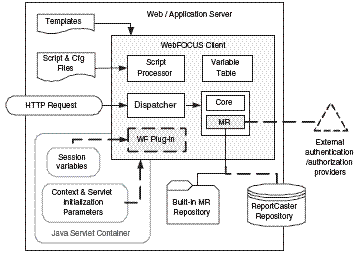The WebFOCUS application can be configured and extended to work with a wide variety of third-party products or customized solutions.
The following diagram illustrates the points in the WebFOCUS Client processing at which customization can be implemented.

The WebFOCUS Client has two points at which customized programs can be used to extend its default processing:
- A Java Servlet filter can be called before each HTTP request is passed to the WebFOCUS application. The HTTP Client (for example, a web browser) sends the request to the web server, which then passes the request to the application server. The Java Servlet filter can intercept the call from the application server to the WebFOCUS application, and can alter the request, respond, or halt execution before the WebFOCUS application receives it. For example, the Java Servlet filter may be used to perform custom authentication.
- The WebFOCUS plug-in can be called before each request is passed to the WebFOCUS Server, whether it is a self-service or Managed Reporting request. Plug-in code can also be called prior to passing results from
the WebFOCUS Server to the WebFOCUS Client. This gives you the opportunity to preprocess a request from the browser and post-process the response
before returning the result to the browser.
To use the WebFOCUS plug-in, the customer site must perform some configuration steps, such as setting WebFOCUS variable values or editing properties. The plug-in provides methods for copying WebFOCUS variables, application server session variables, and HTTP header variables between the WebFOCUS variable table, the application server session, and the HTTP header. For instructions on using this plug-in, see WebFOCUSDB2 Web Query Servlet Plug-in.
If you require preprocessing or post-processing methods not included in the supplied plug-in, you can develop your own plug-in. You should extend the class for the existing plug-in, so that you can still use its methods. A plug-in for the Servlet version of the WebFOCUS Client must be written in the Java language.
On the WebFOCUS Server, custom programs similar to WebFOCUS Client plug-ins are referred to as exits. The WebFOCUS Server has two exits that can be used by WebFOCUS:
- Pre-Verify User ID Exit (PVUIDXT). This exit is used to customize WebFOCUS Server authentication. It can be used to perform the following tasks:
- Configure the WebFOCUS Server to authenticate against a third-party directory.
- Enable a WebFOCUS Server or hub server to establish a secure connection from another WebFOCUS Server or the WebFOCUS Client, without checking credentials. In this case, credentials have already been verified at an earlier point.
- Enable a WebFOCUS Server or hub server to establish a secure connection to another WebFOCUS Server by replacing a verified user ID with a user ID appropriate for the latter server.
- WebFOCUS DBA Exit. This exit enables WebFOCUS metadata to use replaceable parameters for data source security. It is typically used to limit the values in a data source to which a user has access.